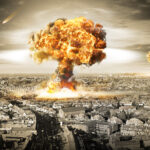by a former Special Forces Officer
“Now I am become death, the destroyer of worlds. (Quoting the Bhagavad-Gita after witnessing the first nuclear explosion.)” -Robert Oppenheimer
The development of atomic weapons fundamentally altered the nature of human conflict and life for our species. The possibility of an all-out, thermal nuclear war has made the possibility of the extinction of humankind a reality. Indeed, for much of the latter part of the 20th century, the threat of nuclear war overshadowed our very existence, with humankind having stood on the precipice of nuclear destruction on more than one occasion.
Today, the possibility of nuclear annihilation reminiscent of the Cold War seems far removed from contemporary consciousness. But for those who grew up during those tension-filled decades, it was an omnipresent threat, one that dominated our thinking about the future. Cold Warriors trained and prepared for the possibility of fighting on a radioactive battlefield. Fallout shelter signs, weekly tests of air raid sirens, and movies like War Games and the TV series The Day After were constant reminders that nuclear war was a very real possibility.
As the war in Ukraine has shown, the threat of nuclear war once again remains a very real military, political and moral concern. As in the darkest days of the Cold War, the threat of nuclear war once again has arisen, lurking in the recesses of our existential consciousness. Veiled threats of the use of tactical nuclear weapons in Ukraine by Russian President Vladimir Putin and Russia’s decision to suspend its participation in the last strategic arms limitations pact with the United States have cast the shadow of a “new Cold War” and resurrected the once unthinkable.
But how does this evolving strategic reality influence the employment of nuclear weapons today? Did nuclear weapons make the Cold War of the past more dangerous, or might their destructive potential have helped keep the Cold War from going “hot” and will that same strategic paradigm hold true today? These are the questions that today’s strategic leaders and military planners grapple with as we face off against a growing list of nuclear-capable adversaries.
How did this “Sword of Damocles” come to dominate and threaten the very existence of our species? The successful development of nuclear weapons by the US and their employment against Japan brought World War II to a final cataclysmic end, but its development set into motion the beginnings of a new, unprecedented conflict, a nuclear arms race with the Soviet Union.
Thanks to perhaps one of the greatest intelligence coups of all time, the Soviet Premier Josef Stalin had firsthand knowledge of the development of the Manhattan Project through communist sympathizers working on the program, namely Klaus Fuchs. This betrayal allowed the Soviet Union to rapidly develop its own nuclear weapons program.
As the Iron Curtain descended upon Europe and the post-war world was divided between two diametrically opposed political and ideological camps, efforts to prevent the proliferation of this new and terrifying weapon began in earnest. The fledgling United Nations sought to eliminate nuclear weapons, imploring the US to give up its nuclear arsenal in exchange for guarantees that other nations would renounce the development of their own nuclear weapons. This “trust but verify” initiative proved stillborn from its inception, as distrust and ambition overshadowed notions of peaceful disarmament. The race to build a powerful nuclear arsenal, capable of destroying the other, was set into motion.
Over the following decades, vast amounts of nuclear weapons and delivery systems were developed by both the US and the Soviet Union. New political frameworks, strategic war plans, and military doctrines developed, all centered around a flawed belief that nations could fight and even win a nuclear war. Air defense and civil defense initiatives augmented those war plans, in hopes of convincing the populations of both sides that one could survive a nuclear war. A new spectrum of conflict developed, from Cold War rivalry and competition to limited conventional war to all-out conventional war to limited, tactical nuclear war and finally to the ultimate, all-out nuclear annihilation under an apropos concept called “Mutually Assured Destruction” or MAD.

With two political ideologies competing for global hegemony, friction points emerged throughout the world. At times, those friction points pushed the world to the brink of nuclear war. The Korean conflict of the 1950s was the first conventional war between Cold War rivals that almost saw the use of tactical nuclear weapons. The Cuban missile crisis in the early 1960s was perhaps the closest the world has come to an all-out nuclear conflict. A major NATO exercise in the early 1980s almost resulted in a strategic miscalculation and an accidental nuclear exchange.
As the last vestiges of colonial empires gave way to nationalist movements in Southeast Asia, Africa, and Latin America, Communism, and Capitalism fought for control of the “hearts and minds”, either through large-scale conventional wars like in Vietnam in the 1960s and 70s, to proxy wars in Africa and Latin America in the 1970s and 80s. All the while, the possibility of those limited conventional wars escalating to a larger nuclear conflict rested in the background. Miscalculation was a frighteningly real possibility, as misinterpretation or accidental launch could potentially trigger an irreversible response from the other side.
Fortunately, the destructiveness of nuclear war and the sheer futility of planning to fight and win a nuclear war precluded those Cold War conflicts from going “the nuclear option.” Nuclear deterrence and the threat of complete nuclear annihilation did keep the Cold War in check and prevented these “hot” conflicts from spiraling out of control.
However, the strategic frameworks that kept us from destroying ourselves in the past are only as good as the memories of those who now hold positions of power. Vladimir Putin and the “hot” war in Ukraine have again raised the specter of miscalculation and nuclear war. Once again, the doomsday clock has crept back into the zeitgeist of our time.
Leaders of the “Free World” today (to coin an ideological relic from the Cold War) must remain resolute and unambiguous of the consequences that any use of nuclear weapons will bring. Strategic messaging to our adversaries must be clear, and backed by credible, capable, and decisive military deterrence. Would the US risk nuclear war in response to Russia’s use of a tactical nuclear weapon in Ukraine? Anything but a “yes” answer in that strategic decision flowchart invites the potential for nuclear adventurism by a misguided or desperate adversary.
Some strategists postulate that providing clear “redlines” on where we will fight and where we won’t fight regarding the use of nuclear weapons offers the opponent an exit strategy in a conflict escalation, an alternative to being painted into the “nuclear-use corner.” Perhaps, but defining those “red lines” and deciding what actions are to be carried out once crossed is often laden with flaws. President Barrack Obama’s famous “redline” over Syrian use of chemical weapons, for example, demonstrates just how meaningless redlines are unless backed by credible military deterrence and the will to use it.
When it comes to nuclear weapons, there is no acceptable use by an adversary that should not generate the threat of an immediate and equally painful retaliation in kind. Unfortunately, without such deterrence, red lines just become finish lines for the enemy to cross.
__________________
This first appeared in The Havok Journal on March 6, 2023.
As the Voice of the Veteran Community, The Havok Journal seeks to publish a variety of perspectives on a number of sensitive subjects. Unless specifically noted otherwise, nothing we publish is an official point of view of The Havok Journal or any part of the U.S. government.
Buy Me A Coffee
The Havok Journal seeks to serve as a voice of the Veteran and First Responder communities through a focus on current affairs and articles of interest to the public in general, and the veteran community in particular. We strive to offer timely, current, and informative content, with the occasional piece focused on entertainment. We are continually expanding and striving to improve the readers’ experience.
© 2024 The Havok Journal
The Havok Journal welcomes re-posting of our original content as long as it is done in compliance with our Terms of Use.



